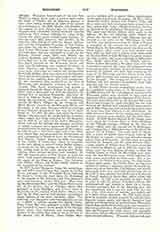

Wireker, NIGEL, satirist, lived about 1190. He describes himself as old in the “Speculum Stultorum”, which was written apparently before 1180. He claims to have known St. Thomas of Canterbury personally, so it was probably before 1170 that he became a monk of Christ Church, Canterbury, where he was, at any rate, from 1186 to 1193, and where he is said by Leland (Collect. III, 8, and Script. I, 228) to have been precentor. In 1189 he was one of the delegates from the monks to King Richard in their dispute with Archbishop Baldwin. The surname Wireker rests on the authority of Bale, and there is ground for thinking that his contemporaries knew him as “Nigellus de Longo Campo”. He was certainly an intimate friend, and may have been a relative, of William Longchamp the Chancellor.
The following are his works, all in Latin: (I) “Speculum Stultorum”, in elegiacs, with a prose introduction, both addressed to one “Willelmus”, who has been identified with Longchamp. This, one of the most popular of medieval satires, is extant in many MSS. and early printed editions, and is included in Wright’s “Anglo-Latin Satirical Poets” (Rolls Series, 1872, I, 3). It narrates the adventures of an ass named Brunellus or Burnellus (whence the poem is cited by Chaucer as “Dann Burnel the asse” in the Nun’s Priest‘s Tale, “Canterbury Tales”, line 15318) in quest of a longer tail. Brunellus, who represents the discontented and ambitious monk, goes first to Salernum for drugs to make his tail grow; losing these on his way home, he studies for a time in Paris, but making no progress he thinks of joining a religious order, and resolves to found a new one, taking the easiest part from each of the existing rules; finally he is recaptured by his old master. Nigel makes full use of the opportunities afforded by this framework for satirizing the manners and customs of his time, especially the vices prevalent among the Paris students and in the several religious orders; (2) “Contra Curiales et Officiales Clericos”, a prose treatise, with a prologue in elegiacs, addressed to William Longchamp as Bishop of Ely, Legate, and Chancellor (printed by Wright, I, 146), and evidently written in 1193-94. As its title suggests, it is a reproof (though affectionate in tone) to Longchamp, and to all who like him attempt to combine the minis-tries of Church and State.
Nothing else of Nigel’s has been printed (with one doubtful exception mentioned below); but several poems are attributed to him (as Nigellus de Longo Campo) in a thirteenth-century MS. which belonged to Christ Church priory (Brit. Mus., Vesp. D. xix). These include (a) verses to Honorius, Prior of Christ Church 1186-88, an elegy on his death (October 21, 1188), and another on that of St. Thomas (December 29, 1170); (b) “Miracula S. Marie Virginis”; (c) “Passio S. Laurentii”; (d) “Vita Pauli Primi Eremite”.
Among them is also the well-known poem on monaetic life, beginning “Quid deceat monachum, vel qualis debeat esse”, which appears in many editions of St. Anselm’s works, and which has also been claimed for Alexander Neckam (Wright, II, 175) and for Roger of Caen (Hist. Litt. de la France, VIII, 421). Another MS. (Brit. Mus., Vitell. A. xi) contains a metrical catalogue of the archbishops of Canterbury down to Richard (d. 1184), which is most probably by Nigel. Wright also credits him (I, 231) with the poem beginning “Si mihi credideris, linguam cohibebis, et aulae”; but this is really John of Salisbury‘s “Entheticus ad Polycraticum”.
J. A. HERBERT

